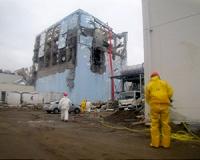| . |  |
. |
Paris (AFP) April 12, 2011 The accident at Fukushima has released "significant" amounts of radiation but at levels and with an impact that are "not comparable" to Chernobyl, France's nuclear safety agency said on Tuesday. "At present... Fukushima is not, nor will it be, Chernobyl, even though it is a very serious accident," the head of the Institute for Radiological Protection and Nuclear Safety (IRSN), Patrick Gourmelon, said. Japan earlier Tuesday hiked its rating of the Fukushima accident from five to a maximum of seven on a worldwide scale, a slot previously only occupied by the April 26 1986 catastrophe in Ukraine. "Releases (of radioactivity at Fukushima) have not changed. It is only a re-evaluation in the light of the strict criteria" used for the International Nuclear Events Scale (INES), said Thierry Charles, in charge of safety at the IRSN. Level seven of INES describes events with "major release of radioactive material with widespread health and environmental effects, requiring implementation of planned and extended countermeasures." In its assessment, the IRSN said Fukushima differed from Chernobyl on several counts, especially on the amount of radioactivity that has leaked. Fukushima has had three reactors that have hit problems, as compared with one at Chernobyl. But the Japanese plant has released only one-tenth of the radioactivity disgorged by Chernobyl because its reactor vessels have so far remained intact, thus keeping almost all of the nuclear fuel enclosed. In addition, radioactive contamination from Fukushima has been "very local" because of prevailing winds and rain, the IRSN said. Most of the contamination occurred between March 12 and 21. At Chernobyl, an authorised experiment went catastrophically wrong, causing the reactor vessel to explode and catch fire, spewing radioactive dust and ash across swathes of Ukraine, Belarus and Russia, even reaching as far west as Ireland. As for the impact on health, exposure to cancer-causing contaminants was worsened in the Chernobyl disaster because the Soviet authorities delayed evacuating the population, distributing iodine pills to protect the thyroid and halting consumption of milk. At Fukushima, in contrast, the authorities swiftly evacuated a zone in a radius of 20 kilometres (12 miles) around the plant and imposed food safety measures, a protocol that can avoid "considerable doses" of radiation, the IRSN said.
earlier related report "Fukushima and Chernobyl are very different," said Denis Flory, head of nuclear safety and security at the International Atomic Energy Agency. "This is a totally different accident. The level of releases and the value for Chernobyl are significantly different," he told a regular news briefing at the IAEA's Vienna headquarters. Earlier Tuesday Japan upgraded its rating of the Fukushima nuclear plant emergency to a maximum of seven on the INES International Nuclear and Radiological Event Scale, placing it on a par with the Chernobyl disaster 25 years ago in the Soviet Ukraine. The reassessment of Fukushima from a level of five to seven, classifying it as a "major accident" with "widespread health and environmental effects", was based on the total radiation released, which Japanese officials said was one-tenth of Chernobyl. Flory said the Japanese estimates put the total radiation release at Fukushima so far at a total 370,000 terrabecquerels, compared with 5.2 million terrabecquerels at Chernobyl. IAEA officials, including the agency's chief Yukiya Amano, have repeatedly pointed out that Chernobyl -- the world's worst-ever nuclear accident -- was caused by human error and a design fault, whereas the crisis at Fukushima was triggered by an earthquake and ensuing tsunami of unprecedented size. In addition, the reactors at Fukushima had been automatically shutdown when the earthquake hit, while at Chernobyl the reactor had been operating. "The mechanics of the accident are very different," Flory said. The Chernobyl reactor did not have a reactor vessel, while Fukushima does and that reactor vessel is still contained even after a series of explosions. That meant that the power of the Chernobyl explosion sent huge amounts of radiation into the high atmosphere "spreading it all over the world". By contrast, the Fukushima reactors were all shut down during the earthquake and there was no explosion in the reactor vessel itself. Flory said the Japanese authorities would have not acted any differently even if the INES rating had been upgraded earlier. "The rating ... does not change what they have done by way of evacuation, sheltering, monitoring of the environment," the IAEA expert said. The INES scale is "not a scale for action, but for communciation. The fact they changed the level does not change anything in the way the Japanese authorities acted." Flory said the overall situation at Fukushima was "very serious, but there are early signs of recovery in some functions" such as the power systems needed to cool the reactors.
Share This Article With Planet Earth
Related Links Bringing Order To A World Of Disasters A world of storm and tempest When the Earth Quakes
 Japan raises nuclear disaster to Chernobyl level
Japan raises nuclear disaster to Chernobyl levelTokyo (AFP) April 12, 2011 Japan upgraded its month-old nuclear emergency to a maximum seven on an international scale of atomic crises Tuesday, placing it on a par with the Chernobyl disaster a quarter-century ago. The reassessment to a "major accident" with "widespread health and environmental effects" was based on the total radiation released, which officials said was one-tenth of the 1986 accident in the then Sovi ... read more |
|
| The content herein, unless otherwise known to be public domain, are Copyright 1995-2010 - SpaceDaily. AFP and UPI Wire Stories are copyright Agence France-Presse and United Press International. ESA Portal Reports are copyright European Space Agency. All NASA sourced material is public domain. Additional copyrights may apply in whole or part to other bona fide parties. Advertising does not imply endorsement,agreement or approval of any opinions, statements or information provided by SpaceDaily on any Web page published or hosted by SpaceDaily. Privacy Statement |